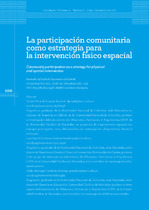Mostrar el registro sencillo del ítem
La participación comunitaria como estrategia para la intervención físico espacial
| dc.contributor.author | Posada Ramírez, Daniel Ricardo | |
| dc.contributor.author | Cardona Jiménez, Luis David | |
| dc.contributor.author | Cardona Restrepo, Pablo Santiago | |
| dc.coverage.spatial | Seccional Medellín | spa |
| dc.date.accessioned | 2021-01-22T14:25:11Z | |
| dc.date.available | 2021-01-22T14:25:11Z | |
| dc.date.issued | 2016 | |
| dc.identifier.uri | http://hdl.handle.net/20.500.11912/7536 | |
| dc.description | p. 100 - 123 | spa |
| dc.description.abstract | ¿Cómo intervenir el territorio de una comunidad vulnerable? Esta fue la pregunta a la que se le intentó dar respuesta, desde el proyecto investigación Intervenciones físicoespaciales a través del diseño y construcción participativa en áreas de interés ambiental, caso sendero, vivero y cancha Fundación Niños de los Andes (2015). El proyecto fue desarrollado entre la Universidad Católica de Manizales, el programa de Arquitectura y la Fundación Niños de los Andes Manizales, y en él se indagó acerca de la relación entre el habitante y el lugar que ocupa, con el objetivo de identificar criterios para transformar, reconstruir, mejorar y afianzar relaciones espaciales entre los habitantes de la fundación y tres espacios propicios para la meditación, la educación y la recreación de una comunidad de niños de 7 a 17 años. Este proceso planteó como estrategia la participación comunitaria para enganchar a la población con actividades sobre estos espacios e intentar trascenderlos en lugares en pos de generar sentido de pertenencia. Esto pone en juego varios aspectos que orientan el caso de estudio: identificar quién lo ocupa, qué siente en este y por este lugar, cómo lo vive…, de la mano con un análisis espacial como estructura paisajística que tiene además de forma, topografía, fauna y flora, la posibilidad de proyectarlo desde la filosofía institucional de la fundación y el deseo y necesidad de sus habitantes de propiciar un cambio en su sentido de vida hacia horizontes mucho mejores e incluyentes. | spa |
| dc.description.abstract | How to intervene the territory of a vulnerable community? This was the question that we attempted to respond, from the research project called Physical and spatial interventions through design and participatory construction in areas of environmental interest: the case of trail, garden center and soccer field Niños de los Andes (Children of the Andes) Foundation (2015). The project was developed between the Catholic University of Manizales, the Architecture program and the Niños de los Andes Manizales (Children of the Andes, Manizales) Foundation. The relationship between the inhabitant and the place he occupies was studied, with the aim of identifying criteria to transform, reconstruct, improve, and enhance spatial relationships between the inhabitants of the Foundation and three spaces that are favorable to meditation, education, and recreation of a community of children of ages ranging from 7 to 17. This process raised a strategy of community participation in order to engage the population with activities about these spaces and to try to transcend them into places in pursuit of generating a sense of belonging. This brings into play various aspects that guide the case study: identifying who occupies it, what they feel in and for this place, how they live it, etc. This is done hand in hand with a spatial analysis as landscape structure with a shape, a topography, a fauna and a flora, but also the possibility of projecting it from the institutional philosophy of the Foundation and the desire and need for its inhabitants to lead a change in their sense of life toward much better and more inclusive horizons. | spa |
| dc.format.mimetype | application/pdf | |
| dc.language.iso | spa | |
| dc.publisher | Universidad Pontificia Bolivariana | spa |
| dc.relation.ispartof | Iconofacto | spa |
| dc.rights | Attribution-NonCommercial-NoDerivatives 4.0 International | * |
| dc.rights.uri | http://creativecommons.org/licenses/by-nc-nd/4.0/ | * |
| dc.subject | Territorio | spa |
| dc.subject | Hábitat | spa |
| dc.subject | Diseño participativo | spa |
| dc.subject | Transformación | spa |
| dc.subject | Apropiación | spa |
| dc.subject | Territory | spa |
| dc.subject | Habitat | spa |
| dc.subject | Participatory design | spa |
| dc.subject | Transformation | spa |
| dc.subject | Appropriation | spa |
| dc.title | La participación comunitaria como estrategia para la intervención físico espacial | spa |
| dc.title.alternative | Community participation as a strategy for physical and spatial intervention | spa |
| dc.type | article | spa |
| dc.rights.accessRights | openAccess | spa |
| dc.type.hasVersion | publishedVersion | spa |
| dc.description.sectional | Medellín | spa |
| dc.identifier.instname | instname:Universidad Pontificia Bolivariana | spa |
| dc.identifier.reponame | reponame:Repositorio Institucional de la Universidad Pontificia Bolivariana | spa |
| dc.identifier.repourl | repourl:https://repository.unab.edu.co/ |


